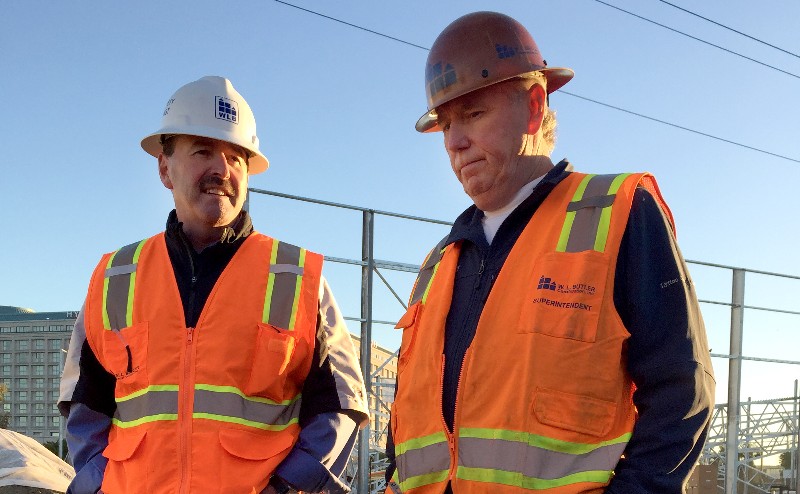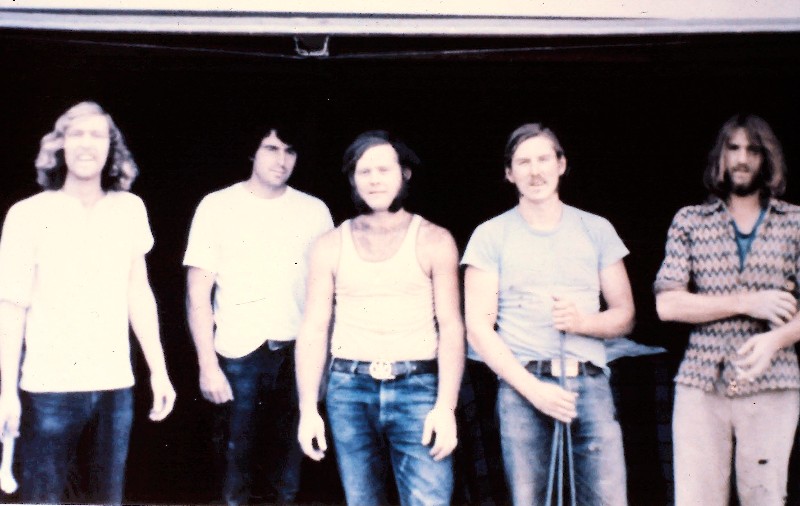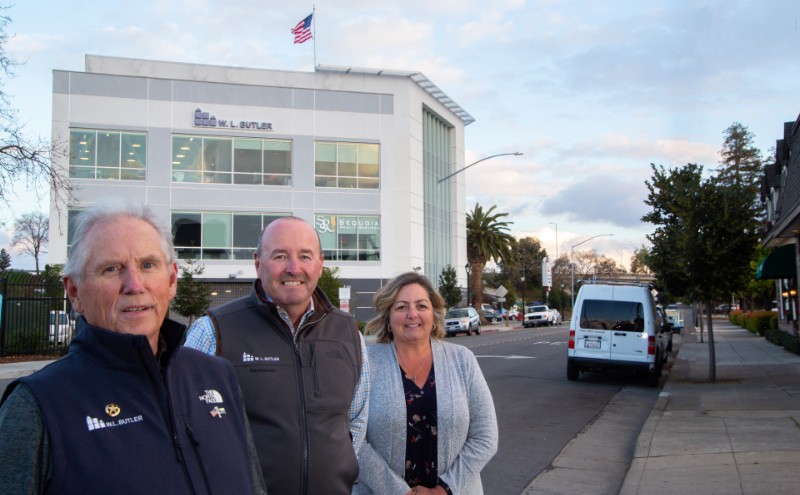By Dan Brown
Bill Butler’s employees tend to stick around for the entirety of their working lives. It’s the clients who can get the quick boot. “Yeah, we turned down $100 million worth of work last year. And we fire more clients than we acquire,” Butler explained. “I won’t mention the name of clients, we fired because … you know.”
After more than an hour in this stately conference room at W.L. Butler Construction headquarters, Butler hardly needs to complete that sentence. He’s spent the time detailing his ferocious loyalty to his workers, and vice versa. There is the handyman he hired at $8 an hour 39 years ago who now serves as the company president. There is the part-time file clerk he hired out of Sequoia High School 37 years ago who now serves as his CFO. There is the laborer who recently retired with nearly $1 million in his 401K.
There are so many employees who have been here for so long that Butler likes to tease the newbies by joking he won’t bother learning their names until they’ve worked at W.L. Butler Construction for at least 10 years.
But why would he fire a deep-pocketed client?
Because … you know.
“If they don’t treat my people like I would treat them. Or if they yell at my people,’’ the Woodside resident said. “I’ve had to fire people because they said, ‘That guy’s a thief. Keep an eye on him.’’’
It helps that there is currently no shortage of polite (and prominent) people in search of W.L. Butler Construction’s services. Butler, now 72, said his namesake company has done about $6 billion worth of business since he partnered with Frank York, that $8-an-hour handyman, nearly 40 years ago. The company did $300 million in business last year alone.
The Company Profiled
So continues an unlikely success story, one that has captured the attention of the corporate world. The noted business book “Small Giants,” first published in 2007, featured W.L Butler Construction as one of the companies that choose to be, as the book’s subtitle reads, “great instead of big.”
The company’s roots go back to the 1960s when a shaggy-haired New York kid fresh off attending Woodstock set out for a road trip to San Diego and wound up in Woodside instead, living in the Star Hill Academy for Anything counter-culture commune with the likes of Neil Young.
Butler was a so-so carpenter in those days. But he had a preternatural gift of gab, so he spent his early days attracting like-minded eccentrics – just so long as they also brought along a work ethic and brains. Today, there are 200 full-salaried employees, many of them representing multiple generations. Butler has hired grandfathers, their sons and their grandsons. He’s hired mothers and daughters.

He attends the baptisms of his employees’ kids, subsidizes rent for single moms and pays college tuitions for his workers who want to continue their educations. The company also has a huge training budget. They call it Butler University. As “Small Giants” recounts, the company once had hired a Portuguese man who didn’t speak English. The supervisors gave him training in reading and writing and he went from building maintenance to customer service.
This is a corporate giant with a mom-and-pop ethos. This is the lemonade stand that takes an actual stand.
“We’ve hired people who worked at Noah’s Bagels because for a month straight, they got your order right,’’ said Gina Henson, that file clerk turned CFO. “And they smiled, and they said, ‘Hello.’ You know, I can work with that!”
The Wall of Fame
Some people drop names. Butler drops buildings.
“That’s SurveyMonkey’s world headquarters. We built that,’’ he said during this spring meeting in his office, casually providing a guided tour of the photos hanging in this conference room. “That building right there? We built it for a guy named Jan Koum, who started something called WhatsApp, OK? And my grandkids are the landlords. And now they have somebody in that building now called TikTok.”
There’s also a photo of Silicon Valley royalty crouching a bit to fit into the frame with Butler.
“And you’ll see he’s bending down because I said, ‘Dave you’re too damned tall.’ So he shrunk down. That’s a guy named Dave Packard,’’ he said, referring to the co-founder of Hewlett-Packard. “And that’s him and me and our CFO at the time. He had a problem with (someone else’s) construction job, and I ended up straightening it out for him and we became business partners. … I worked for Dave until the day he died.”
—
This story appeared in the May edition of Climate Magazine.
—
Butler talks – and talks and talks and talks – like this, spinning rapid-fire tales of chance meetings with local icons that inevitably become lifelong business connections. It’s a pattern that stretches back to his childhood and gives his life the feel of one long happy accident.
Blue Collar Roots
He was born in Clifton Park, N.Y., and grew up on a 100-acre farm in a house that his family forebearers built in 1752. His father was an operating engineer who worked shifts at the original site of General Electric headquarters in Schenectady.
Butler’s father doubled as the town’s assessor, but in title only. It was his mother, a bookkeeper, who quietly handled the duties behind the scenes. “My dad had a ninth-grade education and didn’t know how to do anything other than add and subtract and could barely spell,’’ he explained. “So, she was actually the assessor. But because of the politics in rural areas, you know, it wasn’t going to be a woman.”
Left unsaid is the lifelong effect his mother’s hidden proficiency had on his worldview. Butler now prides himself on identifying resourcefulness in future employees. He has no interest in pedigrees, bluster, reputation, gender, race or ego. He just wants people who, like his late mother, figure things out and get stuff done.
York, in turns, says Butler connects with people from all walks of life because he has no use for pretense.
“You could be having dinner with him, and he will be having a conversation, and he’ll reach over, never lose a beat, take a bite off your plate and keep on talking,’’ he said. “Or he’ll scratch his back with that same fork and then start eating his food.
“And he doesn’t get uptight about being around celebrity. He’ll act the same around David Packard as he would with a laborer on our job site. He just doesn’t change. I mean, some of that’s good. Some of that’s bad. But that’s who he is. It’s like a part of the charm and allure. He only has one ‘Bill’ and that’s who he is. You get the same guy all the time.”
Learning by Doing
In August of 1969, not long after attending the legendary Woodstock concert (Butler keeps his three original tickets framed in his office), he embarked on the happiest accident of all. He hopped into a 1964 Chevy Impala Super Sport and headed West because his girlfriend at the time had a sister living at the Star Hill Academy for Anything commune in the Bay Area.
He agreed to that trip only because he had a limited understanding of the state’s geography.
“I thought San Mateo was next to San Diego,’’ Butler explained.
Still, he managed to catch a wave, arriving in the Silicon Valley at an ideal time to begin easing into the real-estate business. At the commune, he started doing odd jobs like fixing fences and hanging doors. Along the way, he kept meeting other skilled craftsmen and demonstrated a knack for winning over new customers with speedy, precise repair jobs.

Things took a big jump for Butler after a local home burned down and his group rebuilt it in a snap. “The insurance guy said, ‘Wow, you did a great job here. Every time I have a fire, I’m calling you,’’’ Butler said. “And we started doing that. Our original business card said, ‘Fire Reconstruction Specialists.’’’
Even as it thrived, his business in those early days still operated with a free spirit. Butler recalled going to the bank in search of his first home loan, ignoring such details as not having a bank account or having ever filed a tax return.
“They said, ‘How are you going to pay for the house?’’’ Butler recalled. “I opened up my toolbox, pulled out $6,000 in $20s, counted it out. I said, ‘There’s down payment on a $17,000 house.’ Then I fixed it up, sold it for $30,000. I said, ‘Oh! That’s simple. Let me go buy something else.’’’
Shared Success
Suffice to say, Butler keeps better track of the finances now. He said his 200 full-time employees have a combined $44 million in their 401Ks. He takes great pride in the cars they drive, the houses they’ve purchased, the dreams they’ve made realities.
Butler is married with four kids and five grandkids. Both of his sons, Eliott William and Joel Leander, work for W.L. Butler Construction. It’s also worth noting that company headquarters remain as rooted as the employees.
The offices located on Main Street in Redwood City, where lunches at Harry’s Hofbrau are only a few steps away. Their contributions to the Bay Area landscape include projects at the Nueva School, Woodside Priory, Downtown College Prep, the Siena Youth Center and PAMF Women’s Health Center.
“We own property from New York to Arizona, but this is our ‘hood,’’ Butler said. “So, when I make a decision here, it’s not always that the economic basis is the first criteria.
“We make sure we’re not selling a piece of property to an idiot, or somebody who’s going to screw it up. Because we do have some really greedy, self-serving people in this market. But it’s a good town. It’s been very good to us, so we just try to improve it. We like building schools and hospitals and the ASPCA stuff. We like taking care of animals and humans. And building nice buildings. That’s it.”






